31.10.2020
On to the past: Yorgos Maraziotis sets up ambiguous playground in Antwerp
Εικαστικες Τεχνες
Γλώσσα πρωτότυπου κειμένου: Αγγλικά
In his latest solo gallery show, multidisciplinary artist Yorgos Maraziotis lures the viewer into an environment where not everything is what it seems. The exhibition Monroe Springs at Antwerp’s Base-Alpha Gallery consists of paintings and sculptures of different sizes, installed unorthodoxly to create a carefully-planned spatial choreography that puts the viewer’s body into different situations. The deeper visitors delve into the exhibition, the more they realise that behind the show’s apparent softness and playfulness hides a much darker layer, one that is full of violence, social injustice and late-capitalism ennui.
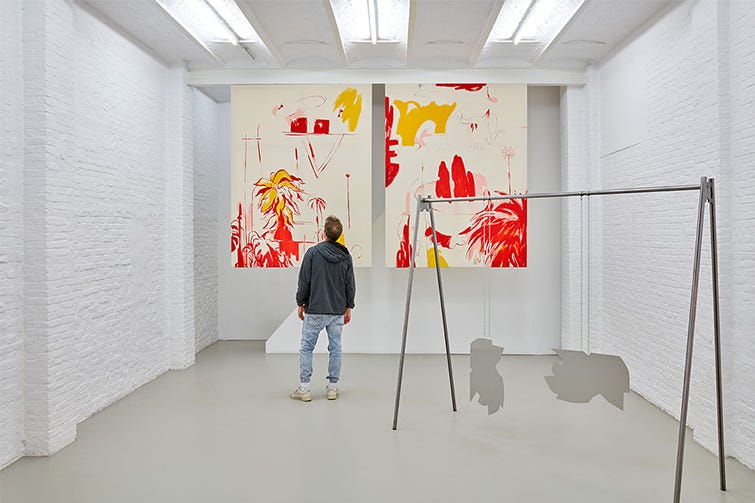
The exhibition’s title refers to an imaginary place, a Californian town perhaps named after Marilyn Monroe. Maraziotis chose this title because he draws inspiration from California, and specifically Los Angeles, for all the works he created for the exhibition. The artist has never visited Los Angeles though; the place exists in his mind as a collage of the representations he has been exposed to over mass media and through popular culture. The show is referencing the city and its history, but at the same time is also addressing the struggles and plight of any western or westernised modern city. Monroe Springs is therefore not a show about Los Angeles, but turns Los Angeles into a metaphor for 21st-century urban societies and the trappings of urbanisation and capitalism.
Upon entering the gallery space, visitors walk past a set of wall-mounted sculptures in the form of Japanese shuriken made of thick pink marble. The weapons’ sharpness is cancelled by the choice of material, and their colour imbues them with an attractive, almost edible quality. Functioning as the exhibition’s ceremonial gateway, a pedestal stands in the middle of the hallway carrying a pair of pristine white roller skates with iridescent details. The shoes are filled with soil into which two pink candles are standing lit. On either side of the pedestal and near the ceiling hang two neon lights in yellow and pink; they are based on a drawing by Maraziotis of cartoonish blood oozing from an invisible wound.
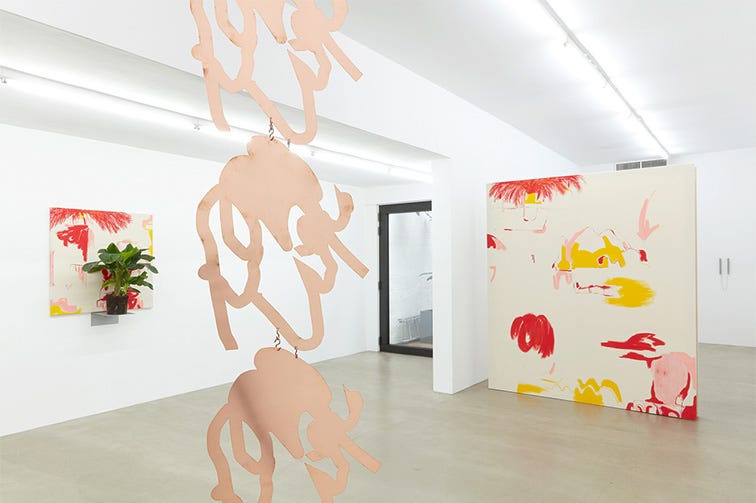
Passing the pedestal visitors find themselves in the exhibition’s first room. A large copper articulated sculpture is hanging from the ceiling like a metal spine made of laser-cut, identical abstract shapes. The impression of the sculpture changes as one moves around it, becoming almost invisible and razor-like from the side but curvaceous and figurative from the front. The shapes are again based on a doodle by Maraziotis, but being cut out of thin metal adds an element of danger and aggressiveness to them. On the wall across, a small painting is sitting on a metal shelf; a plant removed from its pot is placed right in front of it, concealing its content and at the same time duplicating the tropical plants depicted in the painting.
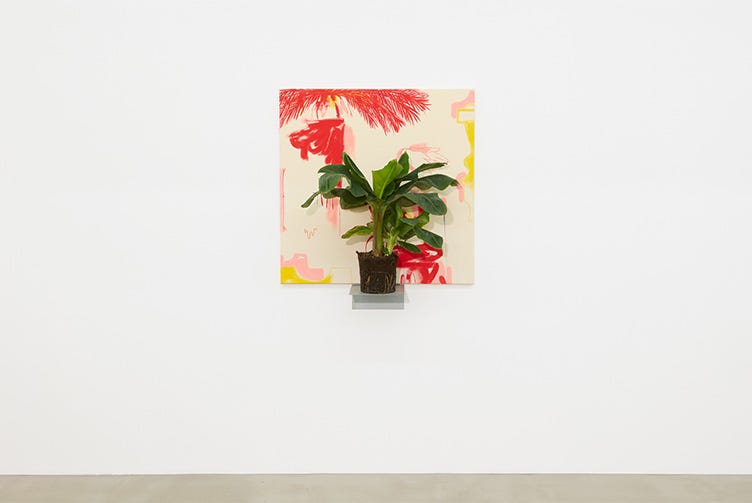
A pair of large paintings standing back-to-back on the floor conceal the entrance to the next room. They have been placed like a wall that separates this first part of the exhibition from the next, creating an indirect path for visitors to follow. Behind the two paintings and mounted on the wall with magnets is a pair of metal nunchaku, the Japanese karate weapon made famous by Bruce Lee and Teenage Mutant Ninja Turtles. Maraziotis’ nunchaku are connected with a very long chain to look more like a skipping rope, confusing in one gesture the limits between violence and play.
In the final and largest room of the exhibition, there are two sculptures. On the left there’s a curving white volume covered in ceramic bathroom tiles and a single metal tube coming out of its top like the railing of a swimming pool ladder. The end of this metal tube that touches the floor is pointed like a weapon. On the other side of the room there’s an austere metal structure that is modelled after a children’s swing with two seats — only in this case the swings are replaced by two angular slates of metal that dangle mournfully from their chains. Above the sculptures, two paintings of identical size are hanging from the ceiling like billboards. A red neon light in the same shape as those in the entrance tints the white wall with an ominous red glare.
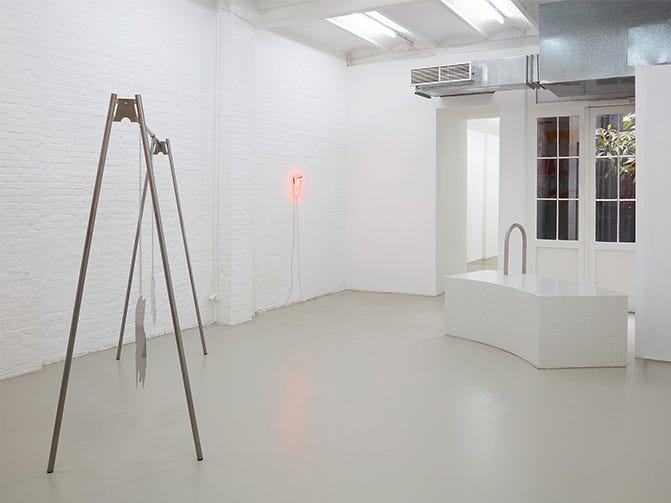
The paintings at Monroe Springs are made using a limited palette of bright yellow, pink and red. At first sight, they seem cheerful and harmless, featuring lush palm trees and cartoonish forms painted sparsely on raw canvas. At closer inspection, and especially when one reads their titles, the paintings are in fact a blood bath, referencing violence both real and fictional. In the first room, the 2,4-meter-high painting Rodney King’s Liquor Circus (2019) is back-to-back with LA Guns (2019), referencing Rodney King’s beating by the LA Police in 1991 and the subsequent riots where over 60 people died. Hanging over the dystopian swings in the back room, the two paintings are referencing Kathy Acker’s violent postmodern writing (Cathy’s Eyelids, 2019) and Disney films (Bunny Love, 2019). The exhibition is constantly referencing the 1980s and 90s through various elements — whether that is the vintage roller skates, karate B-movies, the Los Angeles riots or Acker’s punk literature. This conscious decision relates to the constant tug of war that is taking place between violence and play throughout the exhibition, but also to the artist’s own nostalgia for a childhood that is becoming more and more distant (Maraziotis is after all a Millennial, born in 1984). This very clear reference to the late 1980s and early 1990s also highlights that although we change and move on, history repeats itself: this year we saw another filmed incident of excessive police violence in the US that sparked widespread riots, and we’re again sliding into a recession like in the 1990s.
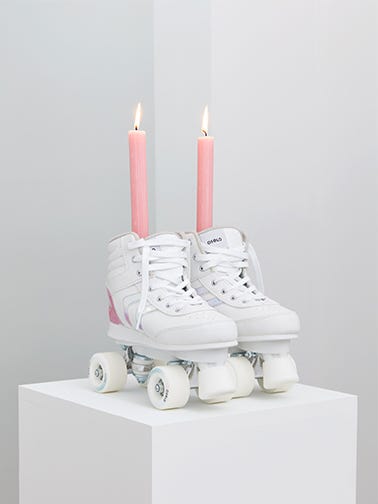
Maraziotis incorporates these issues not only in each work separately but also in the conception of the exhibition as a whole. The nuanced, almost theatrical dramaturgy of moving from one space to the other, the underlying sadness that permeates every attempt to cheerfulness and optimism, the impact that the different materials have on the viewer, the show’s disorienting layout — all are elements that cannot be conveyed via photography and must be experienced in person. That said, Monroe Springs is not just a well-played game of perception and aesthetics, but also a melancholy recollection of the state of the world today. We were promised prosperity and peace, but we ended up with endless war and class oppression. We were promised a playground and we ended up in a torture chamber.
Review by Kiriakos Spirou, originally published on und-athens.com.



